Icteridae
Scott Lanyon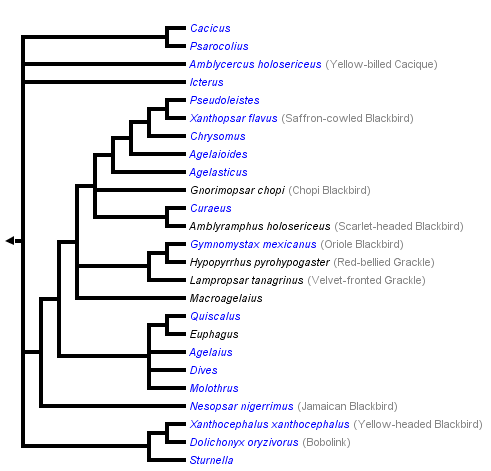


This tree diagram shows the relationships between several groups of organisms.
The root of the current tree connects the organisms featured in this tree to their containing group and the rest of the Tree of Life. The basal branching point in the tree represents the ancestor of the other groups in the tree. This ancestor diversified over time into several descendent subgroups, which are represented as internal nodes and terminal taxa to the right.

You can click on the root to travel down the Tree of Life all the way to the root of all Life, and you can click on the names of descendent subgroups to travel up the Tree of Life all the way to individual species.
For more information on ToL tree formatting, please see Interpreting the Tree or Classification. To learn more about phylogenetic trees, please visit our Phylogenetic Biology pages.
close boxIntroduction
The New World Blackbird clade (Icteridae) consists of 97 species in 27 genera, distributed throughout the western hemisphere. This clade has been of great interest to evolutionary biologists and behavioral ecologists because of the broad range of morphologies and behaviors exhibited. If the archetypical songbird species is monogamous, sexually monochromatic, monomorphic in size, territorial, breeds at age one year, builds a cup-shaped nest, and has a species-specific song, then the New World Blackbird clade contains not only "typical" song bird species, but also species demonstrating a wide range of interesting morphological and behavioral departures from this norm. Within the Icteridae, various species:
- are polygynous,
- are promiscuous,
- are sexually dimorphic in coloration,
- are sexually dimorphic in size,
- are colonial nesters,
- breed at age two years or older,
- exhibit delayed plumage maturation,
- build pendant nests,
- nest in burrows,
- are nest parasites,
- are brood parasites, and
- are vocal mimics.
This clade is the subject of an NSF funded "Assembling the Tree of Life" grant (DEB-0316092) to Keith Barker (University of Minnesota), Kevin Burns (San Diego State University), John Klicka (University of Nevada-Las Vegas), Scott Lanyon (University of Minnesota), and Irby Lovette (Cornell University). Our goal is to sequence multiple genes for every species of "nine-primaried oscine" and to construct a robust phylogeny from these data. This page will be updated once this research has been completed.
References
Cadena, C.D., A.M. Cuervo, and S.M. Lanyon. 2004. Phylogenetic relationships of the Red-bellied Grackle (Icteridae: Hypopyrrhus pyrohypogaster) inferred from mitochondrial DNA sequence data. Condor 106:664-670 .
Johnson, K.P. and S.M. Lanyon. 1999. Molecular systematics of the grackles and allies, and the effect of additional sequence (cyt b and nd2). Auk 116:759-768.
Klicka, J., K.P. Johnson, and S.M. Lanyon. 2000. New World nine-primaried oscine relationships: Constructing a mitochondrial DNA framework. Auk 117:321-336.
Lanyon, S.M. 1994. Polyphyly of the blackbird genus Agelaius and the importance of assumptions of monophyly in comparative studies. Evolution 48:679-693.
Lanyon, S.M. and K.E. Omland. 1999. A molecular phylogeny of the blackbirds (Icteridae): Five lineages revealed by cytochrome-b sequence data. Auk 116:629-639.
Lowther, P.E., R. Fraga, T.S. Schulenberg, and S.M. Lanyon. 2004. Nomenclatural solution for a polyphyletic Agelaius. Bulletin of the British Ornithologistsí Club 124:171-177.
Omland, K.E., S.M. Lanyon, and S. Fritz. 1999. A molecular phylogeny of the New World Orioles (Icterus): The importance of dense taxon sampling. Molecular Phylogenetics and Evolution 12:224-239.
Orians, G.H. 1985. Blackbirds of the Americas. Univ. of Washington Press, Seattle.
Price, J. and S.M. Lanyon. 2002. A robust phylogeny of the oropendolas: Polyphyly revealed by mitochondrial sequence data. Auk 119:335-348.
Price, J. and S. M. Lanyon. R2002. Reconstructing the evolution of complex bird song in the oropendolas. Evolution 56(7):1514-1529.
Price, J. and S. M. Lanyon. Patterns of song evolution and sexual selection in the oropendolas and caciques. Behavioral Ecology 15:485-497.
Price, J. and S. M. Lanyon. 2004. Song and mtDNA identify congruent but novel affinities of the Green Oropendola Auk 121:224-229.
Title Illustrations

| Scientific Name | Agelaius phoeniceus |
|---|---|
| Location | Lino Lakes, MN |
| Specimen Condition | Live Specimen |
| Identified By | Scott M. Lanyon |
| Behavior | Singing and displaying on territory |
| Sex | Male |
| Life Cycle Stage | adult |
| Image Use |
 This media file is licensed under the Creative Commons Attribution-NonCommercial License - Version 3.0. This media file is licensed under the Creative Commons Attribution-NonCommercial License - Version 3.0.
|
| Copyright |
© Scott Lanyon

|
| Scientific Name | Xanthocephalus xanthocephalus |
|---|---|
| Location | Hugo, Minnesota |
| Specimen Condition | Live Specimen |
| Identified By | Scott M. Lanyon |
| Sex | Male |
| Life Cycle Stage | adult |
| Image Use |
 This media file is licensed under the Creative Commons Attribution-NonCommercial License - Version 3.0. This media file is licensed under the Creative Commons Attribution-NonCommercial License - Version 3.0.
|
| Copyright |
© Scott Lanyon

|
| Scientific Name | Icterus galbula |
|---|---|
| Location | Lino Lakes, MN |
| Specimen Condition | Live Specimen |
| Identified By | Scott M. Lanyon |
| Sex | Male |
| Life Cycle Stage | adult |
| Image Use |
 This media file is licensed under the Creative Commons Attribution-NonCommercial License - Version 3.0. This media file is licensed under the Creative Commons Attribution-NonCommercial License - Version 3.0.
|
| Copyright |
© Scott Lanyon

|
| Scientific Name | Cacicus cela |
|---|---|
| Location | Brazil |
| Specimen Condition | Live Specimen |
| Identified By | Arthur Grosset |
| Source | Yellow-rumped Cacique (Cacicus cela) |
| Copyright |
© 2006 Arthur Grosset

|
| Scientific Name | Sturnella superciliaris |
|---|---|
| Location | Brazil |
| Specimen Condition | Live Specimen |
| Identified By | Arthur Grosset |
| Source | White-browed Blackbird (Sturnella superciliaris) |
| Copyright |
© 2004 Arthur Grosset

|
About This Page
The authors thank Arthur Grosset, Giuliano Gerra & Silvio Sommazzi for making their photographs available for this project.
Scott Lanyon

University of Minnesota, St. Paul, Minnesota, USA
Correspondence regarding this page should be directed to Scott Lanyon at
Page copyright © 2006 Scott Lanyon
 Page: Tree of Life
Icteridae.
Authored by
Scott Lanyon.
The TEXT of this page is licensed under the
Creative Commons Attribution License - Version 3.0. Note that images and other media
featured on this page are each governed by their own license, and they may or may not be available
for reuse. Click on an image or a media link to access the media data window, which provides the
relevant licensing information. For the general terms and conditions of ToL material reuse and
redistribution, please see the Tree of Life Copyright
Policies.
Page: Tree of Life
Icteridae.
Authored by
Scott Lanyon.
The TEXT of this page is licensed under the
Creative Commons Attribution License - Version 3.0. Note that images and other media
featured on this page are each governed by their own license, and they may or may not be available
for reuse. Click on an image or a media link to access the media data window, which provides the
relevant licensing information. For the general terms and conditions of ToL material reuse and
redistribution, please see the Tree of Life Copyright
Policies.
- First online 12 October 2006
- Content changed 21 October 2006
Citing this page:
Lanyon, Scott. 2006. Icteridae. Version 21 October 2006 (under construction). http://tolweb.org/Icteridae/67292/2006.10.21 in The Tree of Life Web Project, http://tolweb.org/




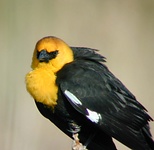
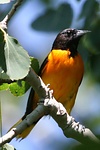
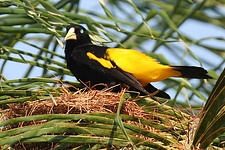
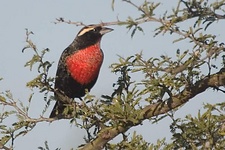





 Go to quick links
Go to quick search
Go to navigation for this section of the ToL site
Go to detailed links for the ToL site
Go to quick links
Go to quick search
Go to navigation for this section of the ToL site
Go to detailed links for the ToL site